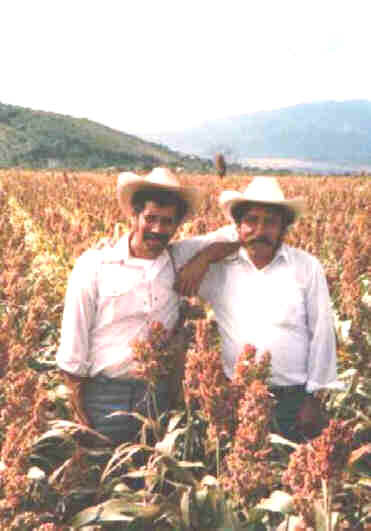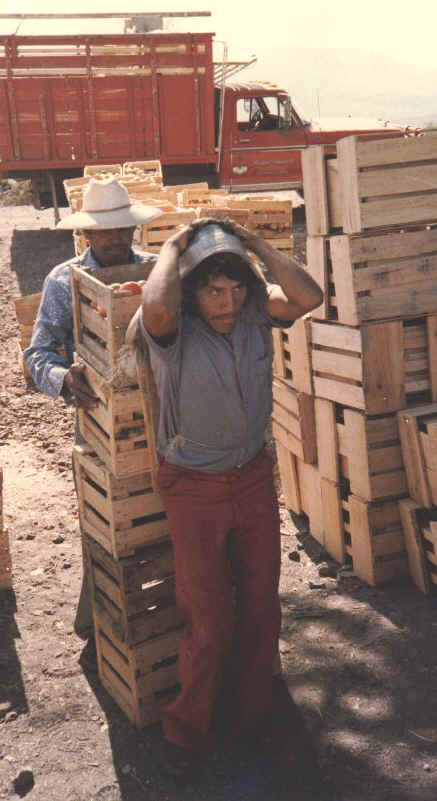 Ejidatarios in a field of sorghum, 1983
Ejidatarios in a field of sorghum, 1983 Ejidatarios in a field of sorghum, 1983
Ejidatarios in a field of sorghum, 1983
The original neolatifundists dedicated themselves primarily to the production of basic grains, helping to make good the deficit caused by falling peasant production, although they were at the forefront of the introduction into the Ciénega of new crops ultimately destined for industrial processing. Sorghum, grown here as a constituent of the balanced feedstuffs fed to cattle and pigs in the commercial meat industry, and safflower, sunflower and other oil seeds, are all susceptible to mechanized sowing and harvesting, for which Ciénega conditions were ideal, given that the majority of the land is flat, unobstructed and susceptible to irrigation.
Exploiting the inability of peasant agriculture to prosper now that it was abandoned by the state, neolatifundist activities were parasitic in the sense that entrepreneurs enjoyed access to ejido land extremely cheaply, but the situation changed somewhat with the arrival of large-scale vegetable growers from the Bajío in the second half of the 1960s. The entry of the tomato growers not only ended twenty years of stagnation of the rental value of land, but created a new demand for labour, including the labour of women and children. This new kind of agribusiness demand for labour was complemented by other developments in nearby regions, in particular the rise of the strawberry agro-industry in Zamora. The strawberry industry recruited young female workers as commuters from the villages on a significant scale in its heyday. Since earnings from international migration also tended to increase after contract labour gave way to undocumented migration following the end of the Bracero program in 1964, this period of deepening capitalist exploitation of the land and labour of the Ciénega peasantry was actually a period of slight economic improvement relative to the previous decade, but the major transformation was yet to come.
 A day-labourer carrying tomatoes, assisted by a foreman who is the landless son of an ejidatario, 1982
A day-labourer carrying tomatoes, assisted by a foreman who is the landless son of an ejidatario, 1982
Video Clip - Click on Quicktime Logo
![]() This clip shows tomato picking and packing on a rented out ejido plot in 1982. The entrepreneur who sowed the tomatoes was a member of a leading family business in the town of Jacona (adjacent to Zamora), administering the enterprise for his sister-in-law, who was a widow. He rented land in various different ejidos throughout the region. The clip opens with shots of the young women and boys who were picking the crop, and shows the tomatoes being loaded onto the backs of the adult carriers. At the entrance to the field, we see the tomatoes being graded and put into packing crates. This particular crop was destined for the US market. The crop's owner supervises every stage of the work personally, alternately joking with and scolding the workers to ensure that the pace of activity is maintained. The pattern of banter is an integral part of the labour control process, given that many of the workers are very young, and the adults are earning much less than they would earn in the United States and expect a lighter work regime in compensation.(Super-8 movie footage transferred to video, no sound.)
This clip shows tomato picking and packing on a rented out ejido plot in 1982. The entrepreneur who sowed the tomatoes was a member of a leading family business in the town of Jacona (adjacent to Zamora), administering the enterprise for his sister-in-law, who was a widow. He rented land in various different ejidos throughout the region. The clip opens with shots of the young women and boys who were picking the crop, and shows the tomatoes being loaded onto the backs of the adult carriers. At the entrance to the field, we see the tomatoes being graded and put into packing crates. This particular crop was destined for the US market. The crop's owner supervises every stage of the work personally, alternately joking with and scolding the workers to ensure that the pace of activity is maintained. The pattern of banter is an integral part of the labour control process, given that many of the workers are very young, and the adults are earning much less than they would earn in the United States and expect a lighter work regime in compensation.(Super-8 movie footage transferred to video, no sound.)